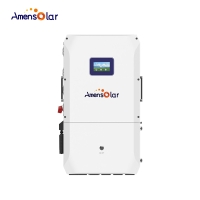Overview of the US Home Energy Storage Market
In recent years, the US home energy storage market has demonstrated strong growth momentum. According to 2023 data, the newly installed
Industry Chain Structure
The industry chain of the US home energy storage market has become relatively stable, consisting of three main segments:
Upstream: Includes battery component manufacturers and supporting equipment suppliers, responsible for providing key materials and accessories required for energy storage systems.
Midstream: Consists of manufacturers of home energy storage batteries and systems, focusing on product development and production.
Downstream: Comprises sellers, service providers, and end users, responsible for product sales, installation, and after-sales maintenance.
Market Driving Factors
Several key factors are driving the growth of the home energy storage market:
Energy Independence & Security: Many households aim to enhance their energy self-sufficiency and reduce reliance on traditional power grids, particularly in regions with unstable electricity supply or frequent natural disasters.
Electricity Price Fluctuations: The unpredictability of electricity prices is prompting consumers to seek cost-effective energy solutions. Home energy storage systems help optimize energy use and lower electricity bills.
Adoption of Renewable Energy: The widespread use of solar and other renewable energy sources has fueled the demand for home energy storage systems to improve energy efficiency.
Policy Environment
While the US policy landscape fluctuates with government transitions, certain states continue to support the development of photovoltaic and energy storage technologies. These policies contribute to market expansion, especially in the context of growing environmental awareness and the increasing demand for energy self-sufficiency.
Technology Trends
In recent years, significant shifts have occurred in the chemical composition of home energy storage batteries. Traditional nickel-based cathode lithium-ion batteries are gradually being replaced by lithium iron phosphate (LFP) batteries due to their superior safety, lower costs, and longer cycle life. Additionally, Chinese companies currently dominate the LFP battery supply chain, prompting the US government to promote domestic battery production to reduce reliance on foreign suppliers.
Conclusion
The US home energy storage market holds significant growth potential. Despite uncertainties in policies and market conditions, the drive for energy independence, security, and renewable energy adoption continues to attract increasing household and business investment, fostering further market development and maturity.

 N3H-X16US 16KW | Split Phase |...
N3H-X16US 16KW | Split Phase |...  N3H-X12US 12KW | Split Phase |...
N3H-X12US 12KW | Split Phase |...  N3H-X10US 10KW | Split Phase |...
N3H-X10US 10KW | Split Phase |...  N3H-X8US 8KW | Split Phase | ...
N3H-X8US 8KW | Split Phase | ...  N3H-X5US 5KW | Split Phase | ...
N3H-X5US 5KW | Split Phase | ...  N1F-A3US 3KW | Split Phase | ...
N1F-A3US 3KW | Split Phase | ...  N1F-A12US 12KW | Split Phase |...
N1F-A12US 12KW | Split Phase |...  N1F-A6.5US 6.5KW | Split Phase ...
N1F-A6.5US 6.5KW | Split Phase ...  N1F-A6.2P 6.2KW | Single Phase...
N1F-A6.2P 6.2KW | Single Phase...  N1F-A6.2E 6.2KW | Single Phase...
N1F-A6.2E 6.2KW | Single Phase...  AMF16000 51.2V | 16KWH | Floo...
AMF16000 51.2V | 16KWH | Floo...  AMW10240 51.2V | 10.24KWH | W...
AMW10240 51.2V | 10.24KWH | W...  LFP 16kWh / LV 51.2V | 16KWH | Floo...
LFP 16kWh / LV 51.2V | 16KWH | Floo...  S52300 51.2V | 16KWH | Stac...
S52300 51.2V | 16KWH | Stac...  S52200 51.2V | 10.24KWH | S...
S52200 51.2V | 10.24KWH | S...  AML12-200 12.8V Series LifePo4...
AML12-200 12.8V Series LifePo4...  AML12-100 12.8V Series LifePo4...
AML12-100 12.8V Series LifePo4...  AML12-120 12.8V Series LifePo4...
AML12-120 12.8V Series LifePo4...  AML12-150 12.8V Series LifePo4...
AML12-150 12.8V Series LifePo4... 